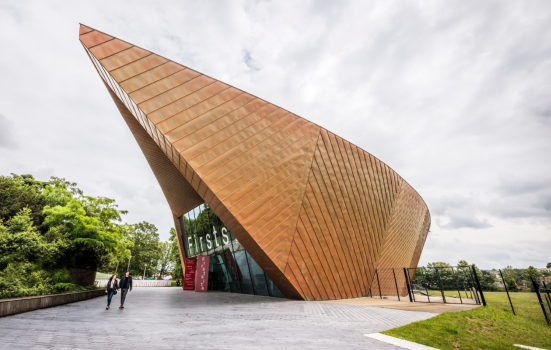Sarah Philp explores the challenge of developing funding to get more people to visit museums and see more art.

Marc Atkins
As the national charity for art, Art Fund has championed and funded UK museums and galleries as they have transformed into increasingly creative, accessible and community-focused spaces. This year in the wake of perhaps the most challenging period for the sector in living memory, we have relaunched our portfolio of funding to better support the sector to look to the future, focusing on how museums, galleries and visual arts organisations can reimagine their ambitions to meet those challenges.
The projects, partnerships and platforms we are funding demonstrate just how resourceful, imaginative and committed museums and galleries are to the collections they care for, and the artists, audiences and communities they serve and show how the sector can continue to rebuild in the months and years ahead.
Community at the heart
Research we published earlier this year identified trends for museums, and what was going to be most important to them. It revealed a new model for the museum, one in which the physical space of the museum is no longer dominant. Instead, the museum divides into three: on-site, on-line, and out in the community - each space equally important and informed by the other two. But in every space, it is people that matter most.
Museums have brought their local communities into the heart of their collections and programming, working off site and online in creative and innovative ways to adapt to the experiences of the last 18 months. And by embracing their closest neighbours, and foregrounding their wellbeing, museums can begin to plan for a different, more connected, future.
Museum of the Year
Our Museum of the Year finalists are extraordinary examples of how this can be done. For the five shortlisted museums - the Centre for Contemporary Art (CCA) in Derry-Londonderry, Experience Barnsley, Firstsite in Colchester and Thackray Museum of Medicine in Leeds - the pandemic provided an opportunity to strengthen existing connections.
They have grown new roots in their localities through a range of projects included becoming a vaccination hub, organising virtual trips to the pub and distributing artist-designed activity packs. The impact of this work will be felt long into the future by both the museums and the people they have reached. We hope they provide inspiration for others.
The Museum of the Year winner was announced last week as Firstsite. Celebrating its 10th anniversary, it is a contemporary arts organisation showing a diverse mix of historic, modern and contemporary art from around the world in an inclusive environment. It has built a strong, critical reputation nurturing long and deep relationships with artists and the local community.
Seizing new opportunities
Museums have been seizing opportunities to reach, understand and connect with audiences more effectively through embracing digital platforms. They have gained greater insight from audience data and used Art Happens to crowdfund, raising vital revenue and converting people who love their organisation into proactive supporters.
We have also taken advantage of digital platforms, championing museums and their collections through our podcast - Meet me at the Museum - and a new series of Art Pass Recommends films. We have also used Art Happens for our own Together for Museums campaign, raising money to put back into our funding programmes.
New thinking about recovery
For many a continual growth model is untenable, and the sector must ask instead what is sustainable across these three spaces in the long term. The issue of sustainability extends to questioning the role museums can play in supporting the health and wellbeing of their audiences, communities and localities – now and in the long term.
And the place of collections is more important than ever in the engagement – and re-engagement – of visitors. This is where our model of holistic support from marketing to funding helps organisations adapt and grow.
Our Reimagine grants are specifically designed to help museums test ideas for what a ‘new model for the museum’ could mean in practice: undertaking projects that inspire creativity, value experimentation and encourage meaningful engagement with diverse audiences. But some existing programmes have new urgency and relevance as museums and galleries look to the future.
Developing specialist skills
As a charity which has had the development of collections at its heart since its earliest days, their renewed importance is especially interesting. Currently we are deciding the next cohort of Headley Fellows, a grants programme that encourages collections-focused projects. It does this by developing specialist curatorial skills and expertise in regional museums, enabling knowledge to be shared as widely as possible both across the sector and – crucially – with audiences.
Fellowship applications come from across the broadest range of collections, from fine art to natural history. And this year we have asked for applications with a decolonisation or community engagement focus responding directly to what we know from our survey are sector priorities.
This month the successful applicants for our Art Fund Weston Loan programme will be announced. It provides training for regional museums to forge partnerships and secure loans from major UK collections to revitalise their own collections. In a future with fewer blockbuster exhibitions, and more focus on the permanent collection to encourage visitors, these partnerships will be even more critical.
With some 130,000 National Art Pass member and a network of 800 museums, together with hundreds of grant recipients, Art Fund has a very strong foundation to live the values of working together and learning from each other. As we look to the future, we will provide further opportunities for communities, collections and colleagues. Whether through funding, advocacy, promotional support, our digital platforms or networks, Art Fund can help bring your plans and projects to life.
Sarah Philp is Director of Programmes and Policy at Art Fund.
This article, sponsored and contributed by Art Fund, is part of a series sharing information and expertise to support museums and galleries to recover from the pandemic and develop audiences for the future.





